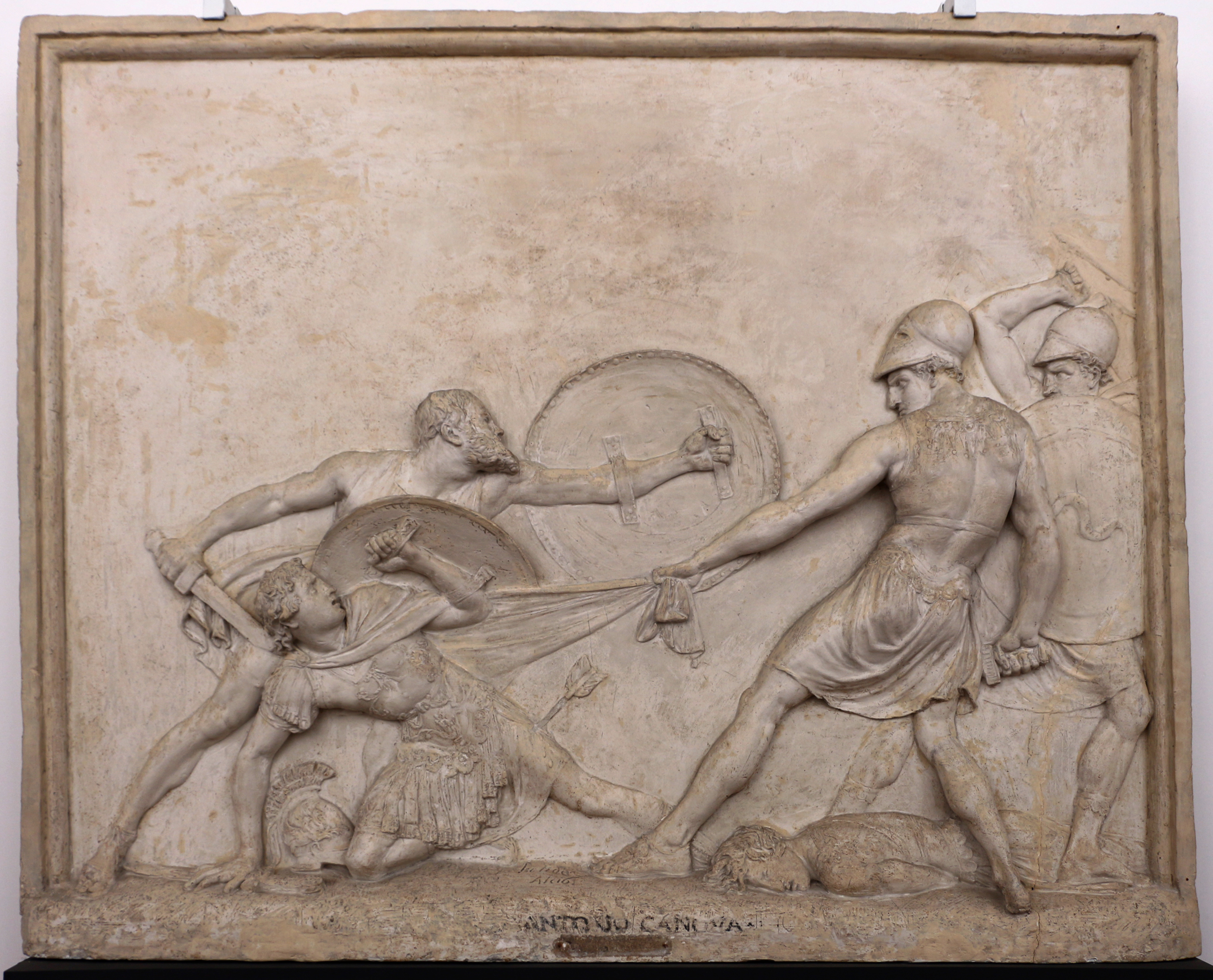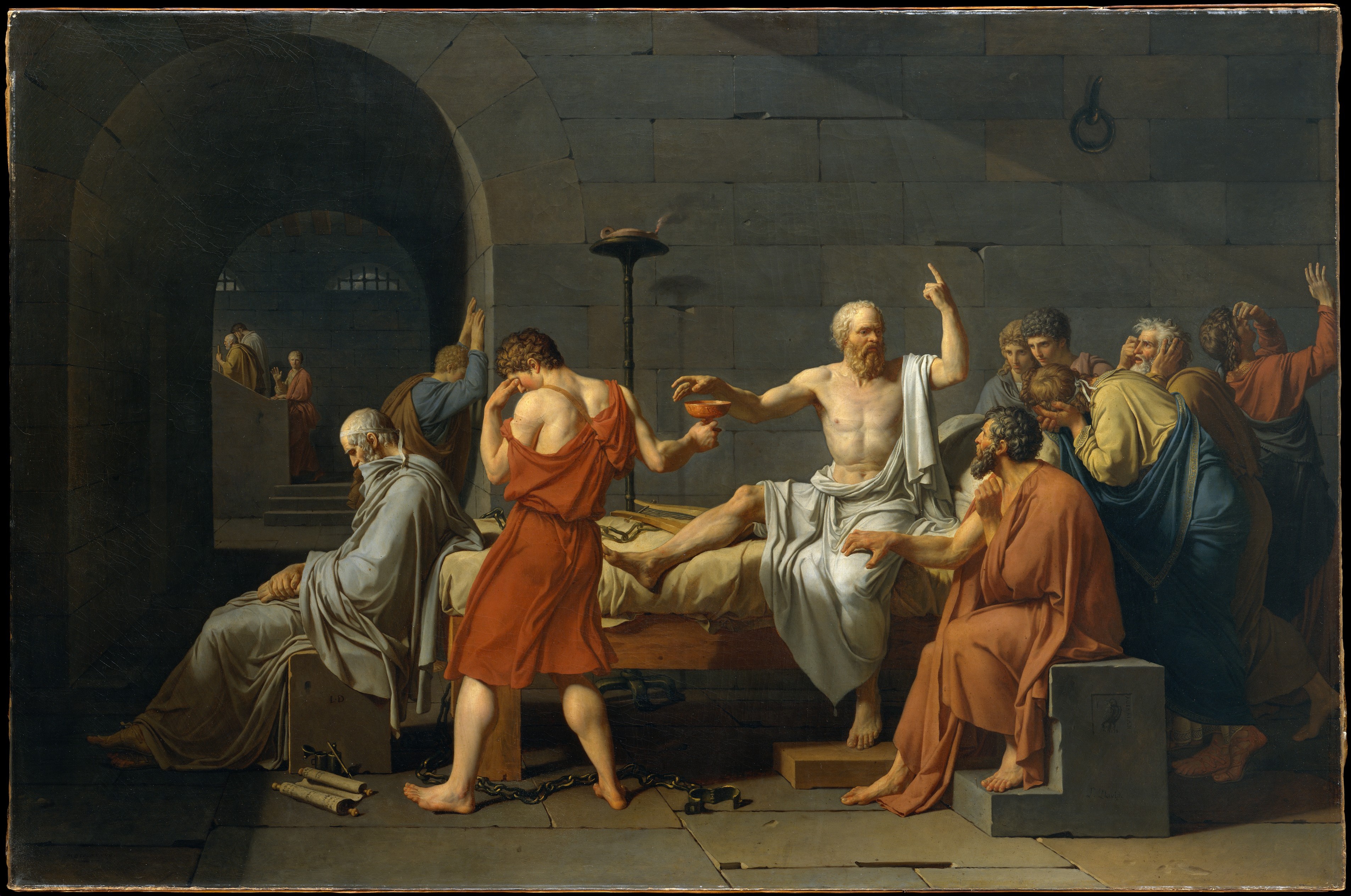-
Lesher, J., D. Nails, and F. Sheffield, editors, Plato's Symposium: Issues in Interpretation and Reception
Diagrams and Illustrations
Acknowledgments
Introduction
Part I. The Symposium and Plato’s Philosophy
1. The Symposium as a Socratic Dialogue, Christopher Rowe 2. The Role of the Earlier Speeches in the Symposium: Plato's Endoxic Method? Frisbee C. C. Sheffield 3. A Platonic Reading of Plato's Symposium, Lloyd P. Gerson Part II. Interpreting Plato’s Symposium
4. Medicine, Magic, and Religion in Plato's Symposium, Mark L. McPherran 5. Permanent Beauty and Becoming Happy in Plato's Symposium, Gabriel Richardson Lear 6. A Study in Violets: Alcibiades in the Symposium, C. D. C. Reeve 7. Where is Socrates on the "Ladder of Love"? Ruby Blondell 8. Tragedy Off-Stage, Debra Nails 9. The Virtues of Platonic Love, Gabriela Roxana Carone Part III. The Symposium, Sex, and Gender
10. Agathon, Pausanias, and Diotima in Plato's Symposium: Paiderastia and Philosophia, Luc Brisson 11. Female Imagery in Plato, Angela Hobbs 12. Plato in the Courtroom: The Surprising Influence of the Symposium on Legal Theory, Jeffrey Carnes Part IV. The Reception of Plato’s Symposium
13. Plato's Symposium and the Traditions of Ancient Fiction, Richard Hunter 14. Some Notable Afterimages of Plato's Symposium, J. H. Lesher 15. The Hangover of Plato's Symposium in the Italian Renaissance from Bruni (1435) to Castiglione (1528), Diskin Clay 16. Platonic Selves in Shelley and Stevens, David K. O’Connor Contributors Works Cited
14. Some Notable Afterimages of Plato’s Symposium [1]
J. H. Lesher
From the fourth century BCE down to the present day Plato’s Symposium has provided a stimulus to reflection on the nature of love. [2] Among the earliest known responses to the dialogue are portions of Xenophon’s Symposium, Petronius’ Satyrica, Plutarch’s Dialogue on Love, Tacitus’ Dialogue Concerning Oratory, and Apuleius’ Metamorphoses. [3] Aristotle composed a symposium-style dialogue on drunkenness, Epicurus wrote one on wine and sex, Heraclides of Pontius one on the effects of food and drink, Maecenas one on the effects of wine, and both Menippus and Lucian wrote philosophical symposia. The Symposium of St. Methodius, although it features ten virgins speaking in praise of chastity, is still a recognizable instance of the same genre. Clearly, the {313|314} format of “after dinner conversations of illustrious individuals” struck many later writers as an attractive framework within which to work. [4]
Near the end of the third century of the common era the philosopher Plotinus elected to read Plato’s Symposium not merely as an account of the nature of erôs—‘love’ or ‘passionate desire’ [5] —but also as an allegorical representation of the different levels of reality and the process by which the human soul, inspired by its perception of physical beauty, ascends from the material world to the realm of intelligible form. Following Plotinus’ lead, many early Christian writers borrowed from the language of the Symposium in describing the process by which the human soul ascends from earth to heaven.
Toward the end of the fifteenth century the Florentine scholar Marsilio Ficino translated the Symposium (first into Latin and later into Italian) and coined the phrase amor Platonicus to refer to the special bond of affection between two men Plato had highlighted in the dialogue. [6] The publication in 1484 of Ficino’s commentary on the Symposium, popularly known as the De Amore, sparked the creation of no fewer than thirty-three “treatises on love” in Italy during the next century alone—works such as the Platonic Discourse upon Love by Pico della Mirandola, the Dialogue on Love by Leo Hebraeus, and the novel Gli Asolani by Pietro Bembo.
Bembo’s view of a “good kind of love”—now strictly heterosexual—was spread to a far wider audience as a result of the publication in 1528 of Castiglione’s Book of the Courtier. During the sixteenth and seventeenth centuries European poets alternately praised and questioned the merits of a distinctly spiritual or “Platonick love.” In the eighteenth century the translation of the Symposium by Floyer Sydenham, later revised by Thomas Taylor, {314|315} spread Plato’s philosophy to a wide circle of readers of English. Plato’s view of natural beauty as merely an imperfect shadow of a Beauty existing in an ideal realm also influenced the thinking of leading figures in the German and English Romantic movements.
During the twentieth century themes and images in the Symposium appear in novels or plays written by Thomas Mann (Death in Venice ), T. S. Eliot (The Cocktail Party ), E. M. Forster (Maurice ), Virginia Woolf (To the Lighthouse), and Yukio Mishima (Forbidden Colors); in essays by the American social reformer Jane Addams; and in explorations of the nature of sexual desire by Sigmund Freud, Jacques Lacan, and Michel Foucault.
Among the works of art inspired at least in part by Plato’s Symposium are sketches by Peter Paul Rubens, Jacques-Louis David, and Hans Erni; and paintings by Anselm Feuerbach and John La Farge, among others. Among musical works there is Erik Satie’s Socrate Suite for Voices and Small Orchestra (the text for part I is drawn from Alcibiades’ speech in the Symposium), and Leonard Bernstein’s Serenade After Plato’s Symposium for Violin, Strings, Harp, and Percussion—each of whose six movements bears the name of a character in Plato’s dialogue. Bernstein’s Serenade has served in turn as the basis for ballets by Jerome Robbins, Serenade for Seven, and Christopher Wheeldon, Corybantic Ecstasies.
In recent years the Symposium has been adapted for performance on stage or television on at least six occasions, including the “musical version of Plato’s Symposium” called All about Love, performed in Colorado Springs, Colorado, in 1997. There was also a 1969 BBC production, The Drinking Party, with Leo McKern as Socrates. Most recently, John Cameron Mitchell’s rock musical Hedwig and the Angry Inch borrows elements of Plato’s Symposium to tell the story of Hedwig’s search for love and happiness after suffering a botched sex-change operation. In the song “The Origin of Love” (written by Stephen Trask) Hedwig draws on Aristophanes’ story of the original race of globular creatures to tell “the sad story of how we became lonely two-legged creatures.”
In what follows I will largely ignore the dialogue’s many literary offspring and focus on a number of its most notable visual aftereffects. After we have reviewed a number of these “afterimages” we will consider what it was about the dialogue that inspired so rich and varied a set of responses.
Perhaps the best-known artistic recreation of Plato’s Symposium is Das Gastmahl des Platon by the nineteenth century German artist Anselm Feuerbach (Figure 1):
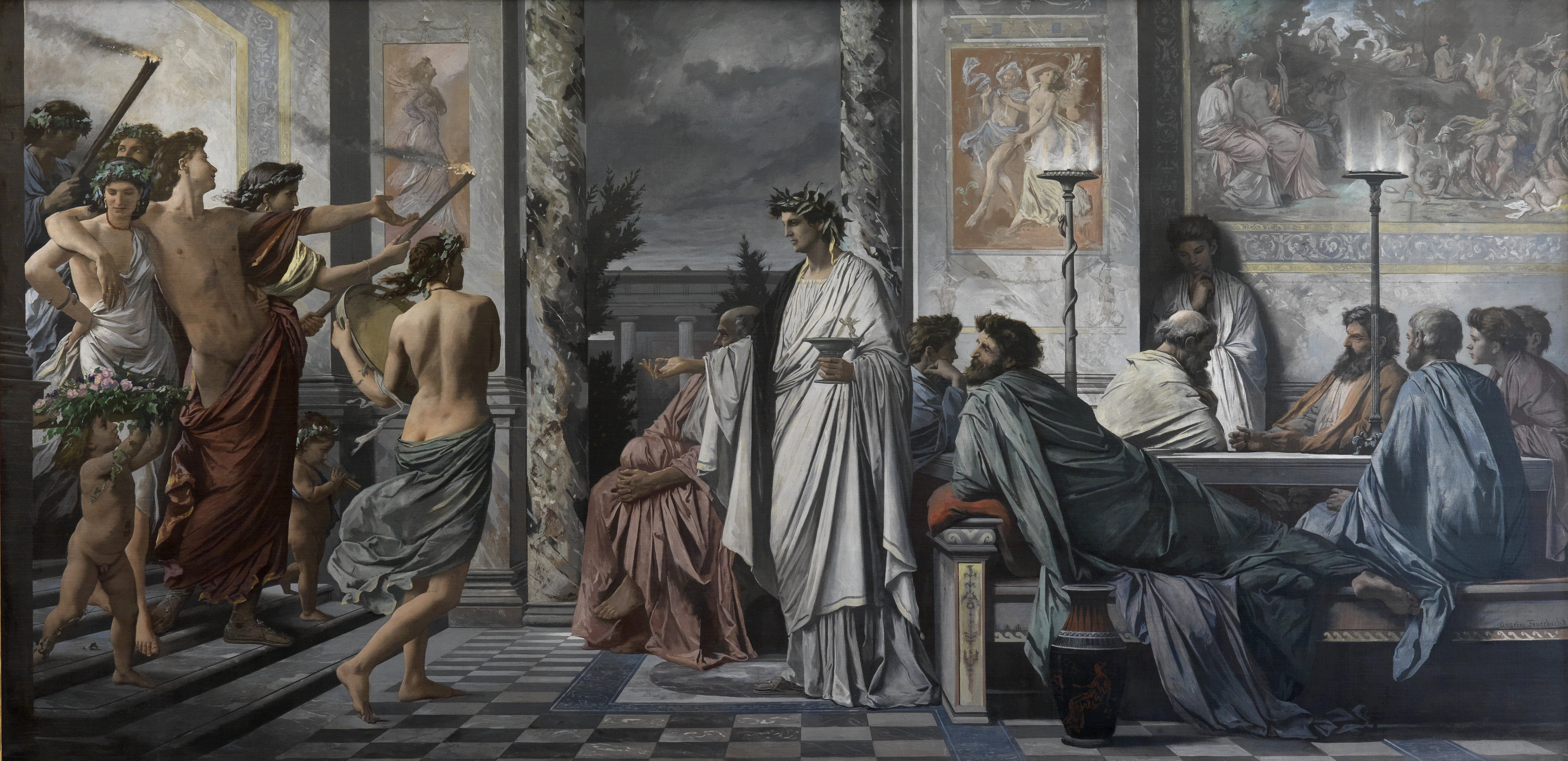
When Feuerbach displayed Das Gastmahl in the 1869 Great International Art Exhibition in Munich, its larger-than-life dimensions, grey under-layering, and muted tones provoked much negative comment. One critic wrote that that the painting reminded him of “a sea of ice that had forced itself undesired into a perfume shop.” Another called it “an extreme of ugliness in form and color which borders on vulgarity and filth … as if Feuerbach had put his paint brush into ink and calcium water instead of color” (Bratke and Schimpf 1980:9). When the painting was purchased and disappeared into a private collection, Feuerbach decided to create a far more colorful and ornate version that since 1878 has been in the collection of the National Gallery in Berlin, now the Old National Gallery. [7]
In the earlier, 1869 version, generally considered the superior of the two works, Feuerbach captures the moment at which Alcibiades enters the dining chamber dressed like the god Dionysus and accompanied by a band of Bacchic revelers. A cherubic figure to Alcibiades’ right holds up the wreath Alcibiades is about to bestow on Agathon, who stands at center stage, extending his right hand in welcome. The identities of the other persons shown in the painting are a matter of debate, but if we assume (as suggested by Heinrich Meier in the introduction to Benardete 1993) that spatial proximity betokens some degree of personal attachment, then the person seated behind Agathon would be his lover Pausanias. Similarly, Eryximachus the physician, identifiable by the cadu{316|317}ceus wrapped around the lamp, would be seated near his friend Phaedrus. Two individuals appear in overlapping images, one facing away from the viewer absorbed in conversation, the other with his gaze fixed intently upon him—almost certainly Socrates with his devoted follower Aristodemus. This would leave only someone sufficiently distinguished looking to be Aristophanes engaged in conversation with Socrates and, at the far right, three other individuals, perhaps the other unnamed guests Plato mentions were in attendance, but perhaps (so Meier suggests) one of them is Plato himself, who would have been about nine at the time the event is supposed to have taken place. If so, then Phaedrus, Aristodemus, and Plato, if that is who it is, would create an isosceles triangle of admirers around Socrates, as opposed to the ragged arrangement of Alcibiades’ cohort. The wall paintings in the background (one depicting the marriage of Dionysus and Ariadne, the other Maenads and a satyr) were perhaps inspired by Feuerbach’s 1866 visit to Naples and Pompeii.
According to his biographer, Julius Allgeyer, in Das Gastmahl Feuerbach was seeking to depict the two contrasting impulses at work in the human psyche—the sensualism represented by Alcibiades and his cohort on the left, and the cool rationalism of Socrates, over on the right. On this reading Feuerbach may be said to have given visual expression to a kind of Dionysian-Apollonian contrast, two years before the publication of Nietzsche’s Birth of Tragedy. But this is probably not the whole story. Feuerbach revealed in one of his letters that he completed the left hand side of the work at an early date and only much later conceived of the grouping on the right hand side: “Certain forms I have carried in me for years before they became useful.” Feuerbach wrote, “At the symposium the group of bacchants of Alcibiades had been present for a long time, only while searching for a suitable counterweight to it, I remembered, through a sudden intuition, Plato’s Symposium” (Bratke and Schimpf 1980:2).
We may also note, since this is not the last time we will see this happen, that Feuerbach provides a somewhat idiosyncratic version of the event. In the description he wrote for the inaugural exhibition he mistook Pausanias for Glaucon; the rather Italianate decor and seating arrangement accord neither with Plato’s description nor the typical configuration of couches in an Athenian dining chamber of the classical period; and the prominence accorded to Agathon in the painting has struck more than one observer as reflecting an exalted view of the poet as someone honored for bringing beauty into being, in much the same way, I suspect, that Feuerbach hoped to be honored for his monumental painting.
The contrast between Alcibiades and Socrates highlighted by Feuerbach appeared more than two centuries earlier in a 1648 etching by Pietro Testa, {317|318} The Drunken Alcibiades, which depicts a naked Alcibiades, this time holding the wreath, set off against the argumentative Socrates, who continues to try to make a point while everyone else is looking in the other direction (Figure 2):

Perhaps by way of a reference to Xenophon's Symposium, a hoop dancer is shown in the background leaving the celebration (the image of the marriage of Dionysus and Ariadne in Feuerbach's Gastmahl also recalled the ending of Xenophon's Symposium). In her study of Testa's work, Elizabeth McGrath (1983:233–234) sees the drawing as a celebration of the kind of youthful naked beauty that can serve both as a contrast and springboard for the ascent to a higher and more profound understanding of love.
A number of later works were inspired by “the wreath incident” recounted at 212a–b. Alcibiades announces that he has come to award a garland to Agathon, “the wisest and most beautiful man” and removes some of the ivy and violets on his own head to place them on Agathon’s. But when he spots Socrates reclining just behind Agathon, Alcibiades attempts to retrieve some of the ribbons to award them instead to Socrates. A somewhat simplistic 1793 {318|319} drawing by Asmus Jakob Carstens [8] depicts the moment at which Alcibiades places the wreath on Socrates’ head while an elderly Agathon looks on.
A sketch by Peter Paul Rubens from around 1602, now badly faded, offers a more complex image (Figure 3):
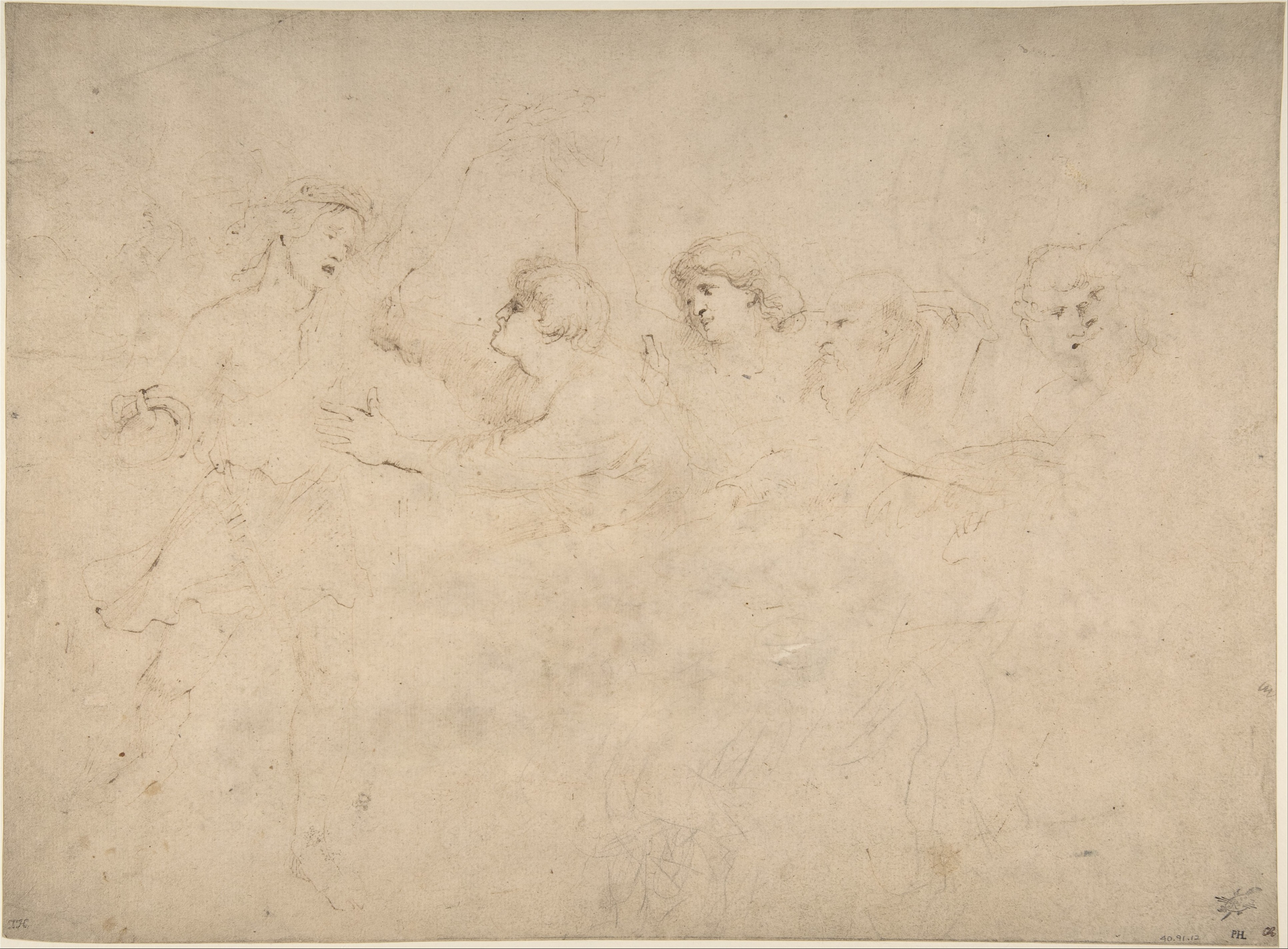
In The Drunken Alcibiades Interrupting the Symposium Rubens depicts Alcibiades wearing one wreath on his head, holding above a second wreath above extended toward Socrates, while at the same time pulling back a third wreath, the one he previously awarded to Agathon. In effect, Rubens has telescoped the entire “wreath incident” into a single image. The result is an ambiguous message, perhaps a reflection of the quicksilver here-today-gone-tomorrow quality of Alcibiades’ sense of loyalty. The motivation behind Rubens’ creation {319|320} of the image is unknown, but one possibility, also suggested by McGrath (1983:234), is that the sketch was created as a gift for a friend, perhaps in remembrance of some memorable occasion during which both love and Platonic philosophy had been in the air.
The nineteenth century “American impressionist,” John La Farge, explored the wreath image in two separate works. La Farge had read widely in Plato and studied in Europe with Thomas Couture—who had been one of Feuerbach’s teachers. In a work La Farge created in 1861 entitled Agathon to Erosanthe we see a multicolored wreath of flowers with the inscription Erosanthê Kalê—“Beautiful love-blossom” or “Love-blossom is beautiful”—barely visible below the wreath and scratched in with reddish-brown ink (Figure 4):
The word kalē evokes the similar inscriptions of KALOS on the ancient cups and drinking bowls members of the Athenian elite bestowed on their favorites. Given the feminine form kalē, the violets, and the natural association of the poet Agathon with the poetic painter La Farge, we might conjecture that in this work La Farge drew on the imagery of Plato’s Symposium to express his love (for Margaret Perry, one assumes, whom he had married the year before). A second La Farge wreath painting entitled Wreath of Flowers dates from 1866 and bears the Greek inscription THEREOS NEON HISTAMENOIO—“as summer was just beginning” (Shields 1997:86). La Farge scholars regard both paintings as highly enigmatic, but I think we can see at least Agathon to Erosanthe as an example of the way in which a particular feature of the Symposium lived on the work of a later artist.
Another memorable feature of the dialogue for many artists was {320|321} the relationship Plato described between Socrates and Alcibiades. One influential depiction was Socrates Leading Alcibiades away from the Dangers of a Sensual Life by Jean-François-Pierre Peyron (Figure 5):
The ancient literary sources for Peyron’s depiction are uncertain (Gillham and Wood 2001:119). As Plato tells the story, Alcibiades rejected Socrates’ attempt to recruit him into the philosophical life and fell back, with a palpable sense of shame and failure, into the pursuit of political power and popularity. At Symposium 216b Alcibiades confesses that: “I’m carried away by the people’s admiration, so I act like a runaway slave and escape from him; and whenever I see him I’m ashamed because of what he’s made me agree to.” The image of Alcibiades as a runaway slave also appears in Plutarch’s Life of Alcibiades: “He would sometimes abandon himself to flatterers, when they proposed to him varieties of pleasures, and would desert Socrates, who then would pursue him as if he had been a fugitive slave,” (6.1). Plutarch tells also how Alcibiades consorted with courtesans (“giving himself up to every sort of luxury and excess among the courtesans of Abydos and Ionia,” 36.2), although he does not {321|322} say that Socrates actually rescued Alcibiades from a group of them. Udolpho van de Sandt has also linked Peyron’s choice of subject with Homer’s account of Hector’s visit to the tent of Paris in Iliad VI, and to an article written by Diderot for his Encyclopedia in which he suggested that artists turn to Plato’s Symposium for suitable subjects (Van de Sandt 2001).
The two male figures shown in Peyron’s drawing appear to be modeled on the ancient statue known as the Apollo Belvedere, with the entire grouping bearing some resemblance to a Hellenistic relief in the collection of the National Museum in Naples, traditionally entitled Youth among the Courtesans (Figure 6): [9]

So Peyron appears to have drawn on both artistic and literary precedents to fashion an image of ancient virtue, or more precisely, to contrast one ancient paragon of virtue with a classic example of the misspent life.
Among the many later re-workings of this theme are Socrates Tearing Alcibiades from the Arms of a Courtesan (1791) by Jean-Baptiste Regnault (Figure 7):
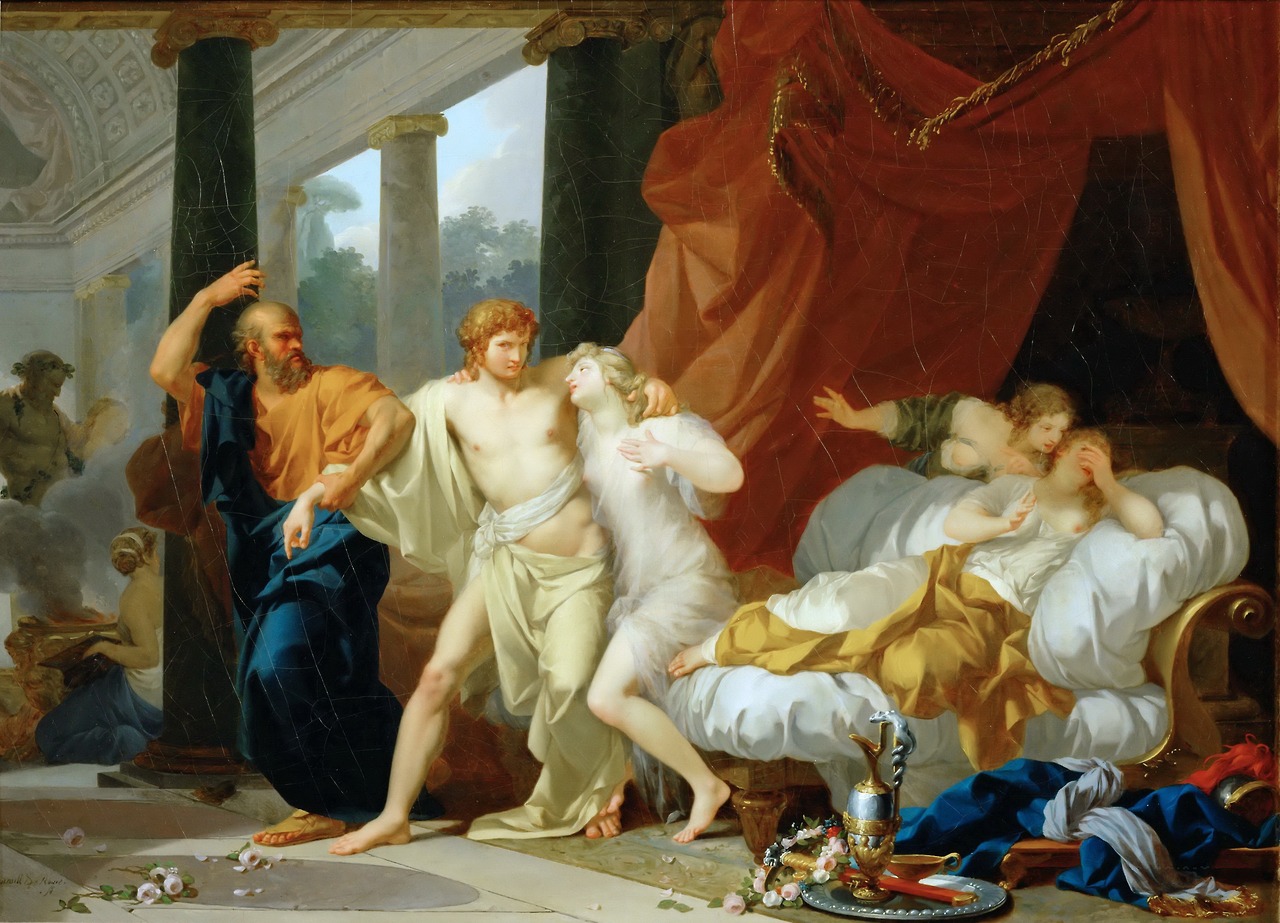
On a similar theme, based on the incident described at Symposium 220e and in Plutarch's Lives, is Antonio Canova's Socrates Rescuing Alcibiades at the Battle of Potidaea (1797) (Figure 10):
There is also a set of sketches done by Inigo Jones, the English architect and artist, that shows Socrates with Alcibiades (Figure 11):
[Image Restricted from Online Edition]
Another memorable aspect of the dialogue was the relationship between Socrates and the mysterious priestess Diotima. Among the earliest of these images may be this bronze relief, part of a decoration on a wooden treasure box found in 1832 in the House of the Decorated Arches in Pompeii (and now in the collection of the National Archeological Museum in Naples) (Figure 12):
[Image Restricted from Online Edition]
Within a decade after the box had been found one scholar (O. Jahn) observed that it reminded him of the scene in Plato’s Symposium in which Diotima instructs Socrates in the ways of love. In his recent study of the image of the intellectual in antiquity Paul Zanker states that the decoration “probably depict[s] Socrates’ initiation into the mysteries of love by Diotima” (Zanker 1996:37). But others have challenged this interpretation, noting the oddity of an object bearing a scene from a Platonic dialogue appearing as early as the second half of the fourth century BCE as well as the correspondence on a number of points between the female figure and images of the goddess {326|327} Aphrodite on a number of small bronze mirrors (discussed in Schwarzmaier 1997). On this alternative reading, we see Aphrodite looking on as a Silenus teaches Erōs to read. Others have focused on what appears to be a necklace in the hand of the female figure, suggesting that it is an image of a hetaira, perhaps Aspasia, with Erōs and an unidentified observer.
From more recent times is a sketch by Jacques-Louis David, recently purchased by the National Gallery of Art in Washington, which unambiguously depicts Diotima instructing Socrates (Figure 13): [10]
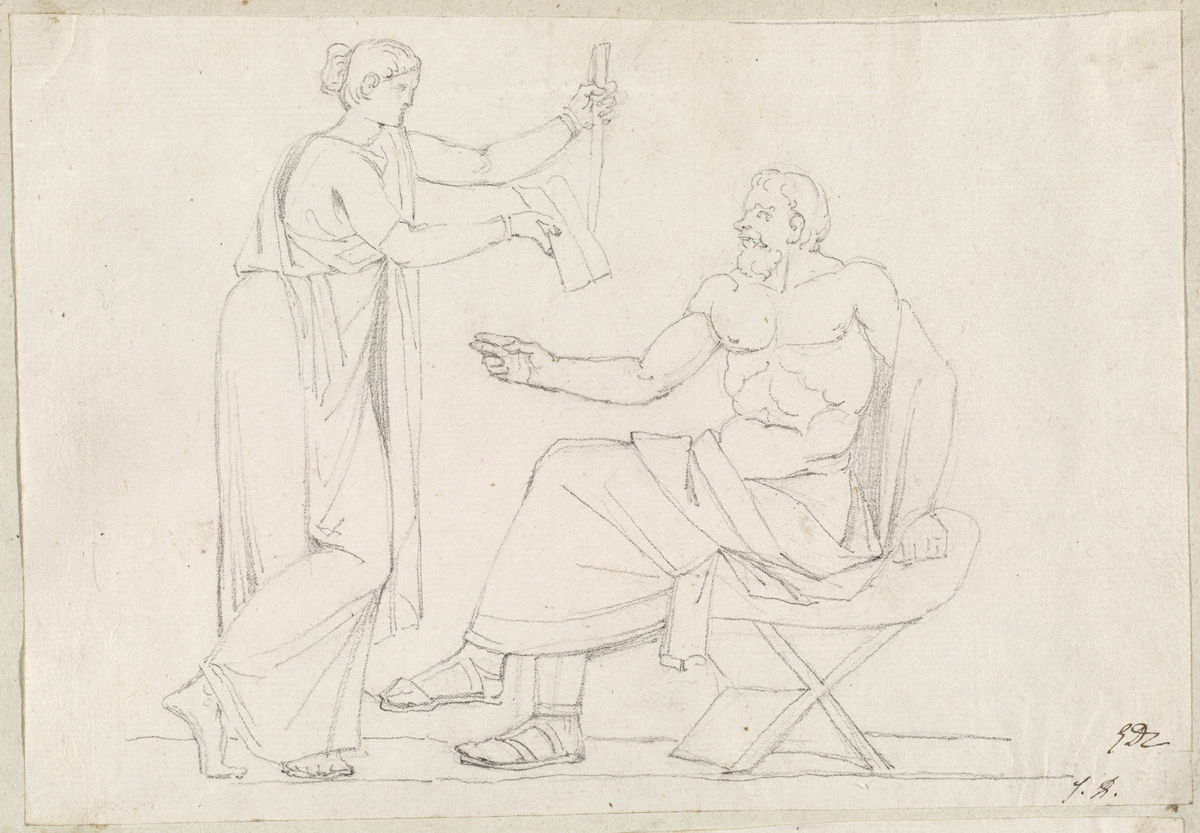
That this is David's Socrates is made evident by a comparison with the image of the Socratic torso in David's well-known Death of Socrates (Figure 14):
There is also a set of sketches of Socrates with Diotima by the contemporary Swiss artist Hans Erni (Erni 1971).
Diotima’s speech to Socrates, as one would expect, inspired imitation on several points, especially as the ascent passage was read and reinterpreted by a series of Neoplatonic thinkers. In his reformulation of Plato’s account, Plotinus described love and beauty as cosmic powers locked into a continuous cycle of emanation and return as divine love first imparts beauty to the world, and then created beauty draws us up and back to our divine source. Plotinus writes:
As the historian Anders Nygren showed, this vision of the soul inspired by love of divine beauty to ascend a celestial ladder pervades much of early Christian thought: “For a thousand years ... the ladder-symbolism characteristic of Eros piety sets its mark almost without question upon the general conception of Christian fellowship with God” (Nygren 1953:594). One image of the ladder to heaven appears in an early fourteenth-century manuscript based on the writings of the sixth-century hermit Johannes Climacus or St. John of the Ladder (Figure 15):
The born lover … has a certain memory of beauty but, severed from it now, he no longer comprehends it: spellbound by visible loveliness he clings amazed about that. His lesson must be to fall down no longer in bewildered delight before some one embodied form; he must be led, under a system of mental discipline, to physical beauty everywhere and made to discern the One Principle underlying all … he must learn to recognize the beauty in the arts, sciences, virtues; then these severed and particular forms must be brought together under the one principle by the explanation of their origin. From {328|329} the virtues he is to be led on to the Intellectual Principle, to the Authentic-Existent; thence onward, he treads the upward way.
Plotinus Enneads 1.3.2
[Image Restricted from Online Edition]
The simile of the celestial ladder of love and beauty also appears in the writings of Gregory of Nyssa, St. Augustine, Pseudo-Dionysius the Areopagite, Boethius, and St. Bonaventure, among others. It can also be found in Books 21 and 22 of Dante's Il Paradiso when another female spiritual guide, Beatrice, leads the poet from the sphere of Saturn up to the realm of the fixed stars:
I saw—the color of gold as it relfects
The sun—a ladder gleaming in the sky,
Stretching beyond the reaches of my sight.
The sun—a ladder gleaming in the sky,
Stretching beyond the reaches of my sight.
Dante Il Paradiso 1984:28, 21.28–30 [11]
[image Restricted from Online Edition]
Perhaps the most influential feature of Diotima’s account turned out to be the basic distinction between physical and spiritual love—i.e. between love of a beautiful body and love of a beautiful soul. Many later readers—from Plotinus to Ficino and beyond, extracted the same distinction from the contrast drawn by Pausanias between the Heavenly and Common Aphrodites. Pausanias had introduced the distinction in his defense of love on the classic pederastic model, [12] but in his commentary on the Symposium Ficino repre{330|331}sented Pausanias’ distinction as a contrast between any desire for physical union fueled by our senses of smell, taste, and touch, and the enjoyment of a person’s mental and moral qualities acquired through sight and conversation. Ficino’s version of the two forms of love surfaces in the novel Gli Asolani of Pietro Bembo when, after previous speakers have alternately praised and censured love, the gentleman Lavinello asks: “Who can fail to see that if I love some gallant, gentle lady, and love her more for her wit, integrity, good breeding, grace, and other qualities, than for her bodily attractions, and love {331|332} those attractions not for themselves but as adornments of her mind—who can fail to see that my love is good because the object of my love is likewise good?” (Bembo 1954:158). This contrast between, essentially, physical and spiritual love found its way into the visual arts where, according to Kenneth Clark, it “formed the justification for the female nude.” Clark (1956:71) explains:
Among early examples of the Heavenly Venus/Aphrodite cited by Clark are the Knidian Aphrodite of Praxiteles, from around 330 BCE (known to us only through later copies), and the famous Aphrodite of Melos—the Venus de Milo—from around 100 BCE (illustrated in Clark 1956). Art historian Erwin Panofsky (1969:109–138) has also linked the distinction between the two Aphrodites to the work of Titian traditionally called Sacred and Profane Love, arguing that the unclothed woman represents the “naked truth” or Heavenly Venus, while the clothed or “worldly” figure is her natural twin, though this reading has been challenged by others.
... because it symbolized a deep-seated human feeling, this passing allusion [made by Pausanias] was never forgotten. It became an axiom of medieval and Renaissance philosophy. It is the justification of the female nude. Since the earliest times the obsessive, unreasonable nature of physical desire has sought relief in images, and to give these images a form by which Venus may cease to be vulgar and become celestial has been one of the recurring aims of European art. The means employed have been symmetry, measurement, and the principle of subordination [i.e. of part to whole].
Another relevant image is provided by one of the most famous works in the permanent collection of the (American) National Gallery of Art, Leonardo’s Ginevra de’ Benci, completed at some point in the late 1470s. [13] There is some uncertainty about the exact date of the painting and the occasion for which it was created, but the inscription on the back of the painting, Virtutem Forma Decorat—“Beauty Adorns Virtue”— provides a helpful clue. The wreath of laurel and palm, which surrounds the inscription, was the personal emblem of Bernardo Bembo, the Venetian ambassador who came to Florence in the late 1470s and, during his visit, proclaimed Ginevra de’ Benci to be his “Platonic love.” What Leonardo created, then, was essentially a visual representation of Platonic love—of physical form as the outward show of an inner, spiritual beauty. [14] {332|333}
Many scholars have linked the distinction between the two Aphrodites to Botticelli’s famous works Primavera (Figure 18) and The Birth of Venus:

In Primavera or Fiorenza created around 1477, Botticelli presents a tapestry of earthly delights presided over by a richly-clothed Venus/Aphrodite figure, with Cupid/Eros firing his darts of love down from above. On the right side of the painting Zephyr pursues Chloris who is transformed into Flora, the goddess of vegetative growth, with the three graces and Mercury over on the left. On one level, Botticelli gives us a visual image of the ancient carmen rusticum or “country song,” drawing on accounts of the first appearance of spring in Lucretius’ De rerum natura, Ovid’s Fasti, and the Odes of Horace. [15] But on a more symbolic level Primavera may be seen to reflect the process through which love and desire beget natural beauty, which in turn draws the mind upwards toward the more rational forms of which they are reminiscent. [16] {333|334}
In the Birth of Venus, created around 1486, we find the Common Aphrodite’s naked counterpart, the Heavenly Venus/Aphrodite arriving on the Italian shore, transported by divine powers from her oceanic birthplace (Figure 19):

This is clearly the Aphrodite born from the foam created when the severed genitals of Kronos were cast into the sea. Her modesty—as revealed by the arrangement of her arms—and her elegantly balanced stance mark her as a direct descendant of the Heavenly Aphrodites of antiquity.
For several centuries European poets created an array of sonnets, plays, songs, and masques that explored and sometimes ridiculed the “Platonic” notion that men and women should seek a spiritual rather than physical union. In the 1630s the English playwright William D’Avenant created entertainments such as The Temple of Love and The Platonic Lovers for the amusement of the lords and ladies of the court of Queen Henrietta Maria, in performances in the magnificent Banqueting House designed by Inigo Jones. One observer of the London scene wrote to a friend that, “... there is a Love called Platonick Love which much sways here of late. It is a Love abstracted from all corporeal, gross impressions and sensual appetite, but consists in contemplations and ideas of the mind, not in any carnal fruition” (James Howell in Jacobs 1982:1:317–318). {334|335} Jones explained that he designed a costume for Queen Henrietta’s appearance in one of her Platonic masques “so that corporeal beauty, consisting in symmetry, colour, and certain inexpressible graces, shining in the Queen’s Majesty, may draw us to the contemplation of the beauty of the soul, unto which it hath an analogy” (Strong 1973:159).
With the masques of the Stuart court we come face to face with an aspect of the Symposium that has been in the background all along—namely, the dialogue’s dramatic character. Other dialogues of Plato feature the occasional dramatic moment—the death scene in the Phaedo and Thrasymachus’ outburst in Republic I come to mind—but the Symposium is, and was intended to be, a philosophical drama rich in scenes that could be readily visualized in the mind’s eye.
After an introductory framing narrative, the drama proper opens with Socrates and Aristodemus walking together toward the house of Agathon—we might compare the image of arriving symposiasts in the mural in the Tomb of the Diver at Paestum (Figure 20a):
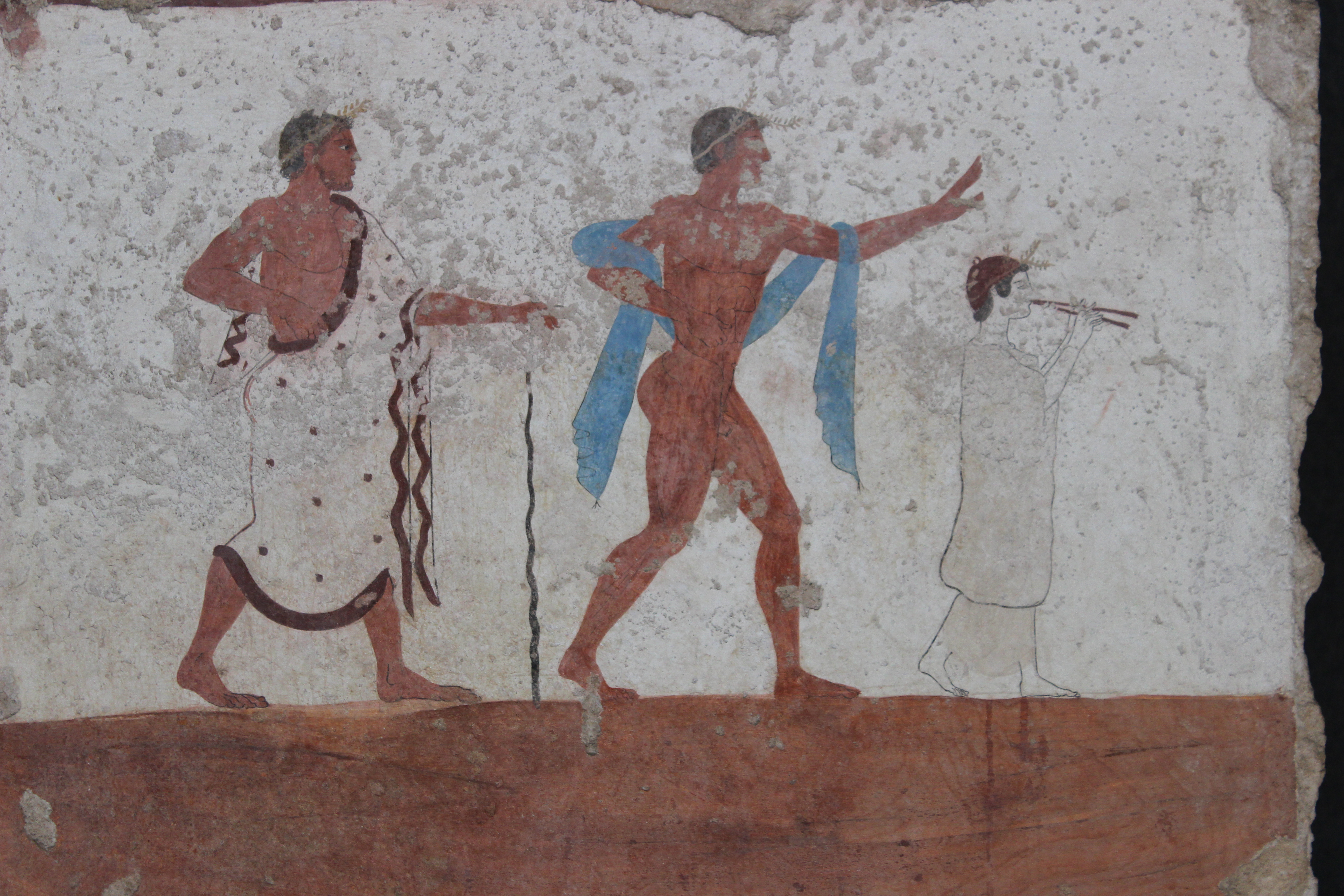
although at 175a Plato gives the additional striking detail that Socrates has stopped lost in thought on the porch of the house next door. We are then told that the group “poured libations, sang a hymn, and performed all the customary rituals” (176a, as again depicted in the Paestum mural, Figure 20b): {335|336}

While the speeches of Phaedrus, Pausanias, and Eryximachus contain few dramatic moments, the tone changes abruptly when we come to Aristophanes’ memorable account of the race of original round creatures of three types—double men, double women, and the man-woman or androgyne—Zeus decided to slice in half when they threatened to occupy the domain of the gods. An image of these remarkable creatures appears on a medal coined in honor of the Paduan philosopher Marcantonio Passeri, with the caption “With philosophy leading, we retrace our steps” (Figure 21): [17]
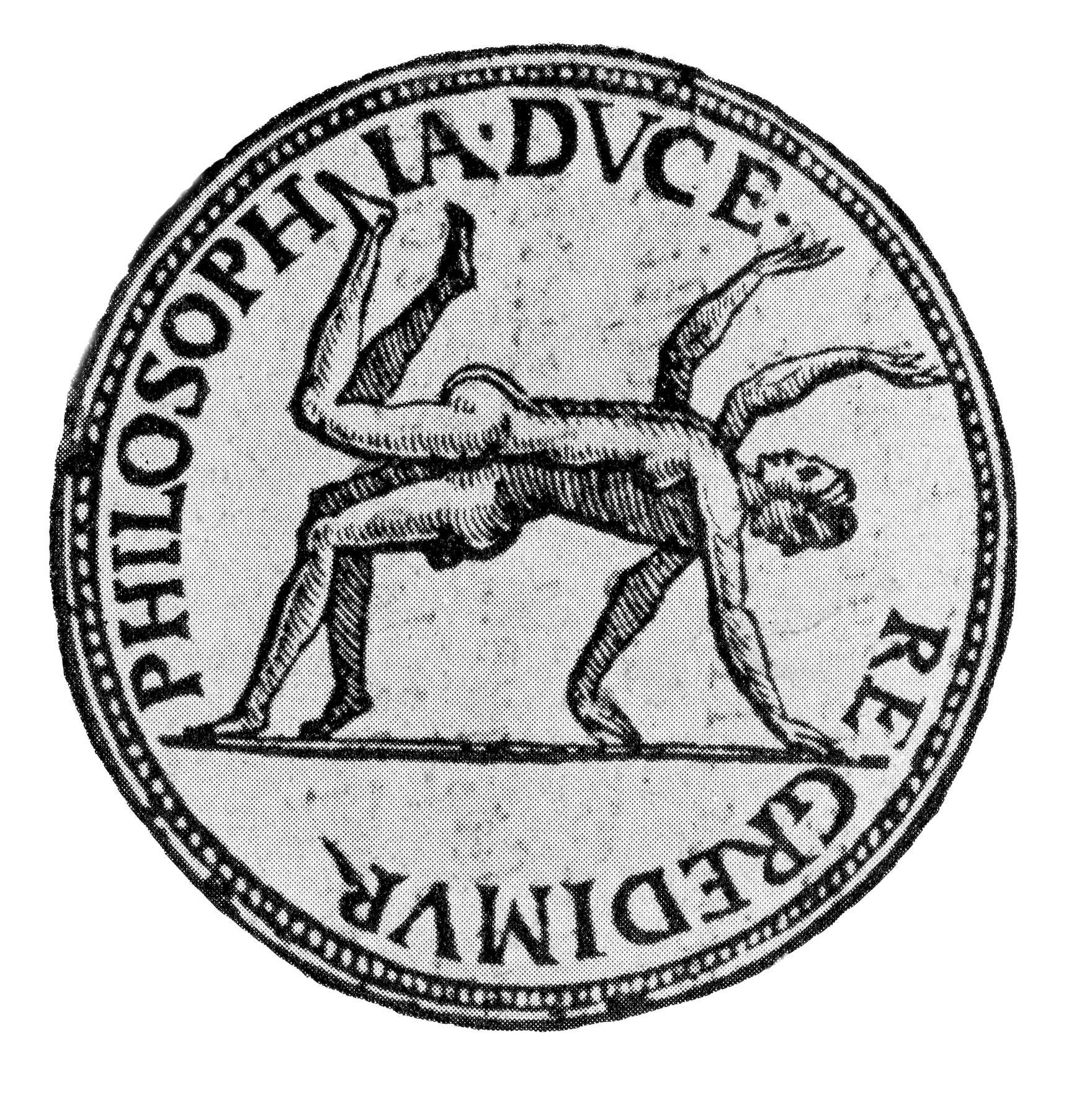
An image of the "children of the sun" also appears in the rock musical Hedwig and the Angry Inch (Figure 22):
[Image Restricted from Online Edition]
Hedwig and the Angry Inch, copyright MMI, New Line Productions, Inc. All rights reserved. Photo appears courtesy of Emily Hubley and New Line Productions, Inc.
Even something so abstract as the process of abstraction is effectively dramatized through the importation of the language of the Mysteries and the visual simile of the ladder of love. Next comes the dramatic entrance of the drunken Alcibiades, his accounts of his failed attempt to seduce Socrates and of Socrates’ various military exploits, and the final breakdown of order upon the arrival of an uninvited mob. In the drama’s final scene, Socrates sets out with Aristodemus in tow for another day of the philosophical life.
The dramatic character of the Symposium has made it a natural choice for performance on stage or on television (see the recent performances mentioned at the outset of the paper). In 1969 the BBC broadcast a version of the Symposium written for television by Leo Aylen, directed by Jonathan Miller, and featuring Leo McKern in the role of Socrates. Aylen has explained {337|338} how he came to be involved in the production: “Jonathan started talking about how he wanted to put dialogues on TV and asked me about Plato. I said very quickly that Plato’s dialogues were excellently dramatic—quite as dramatic as some Shaw plays, and that the obvious dialogue to start with was the Symposium, because of the vividness of its characters.” [18] The classicist Kenneth Reckford has argued that T. S. Eliot modeled his play, The Cocktail Party, on Plato’s Symposium. Reckford notes that both titles mean “drinking party,” both involve “libations” and both describe a merry scene in ways that mask deeper philosophical and religious concerns. Reckford identified Sir Henry Harcourt-Reilly who provides spiritual therapy and moral insight, as Socrates, and Julia Shuttlethwaite as Diotima. Reckford also notes the similarity in overall narrative structure: both works “move inward from a convivial, secular periphery to a philosophical or religious center of meaning and vitality, and then out again” (Reckford 1991:303–312).
In his conversation with Agathon at 194a–b Socrates likens their present speeches to a theatrical performance; at 222d he likens Alcibiades’ speech to a satyr play; and the concluding conversation between Socrates, Aristophanes, and Agathon suggests that the dialogue itself should be seen as a kind of philosophical drama. In any case, the dialogue’s many memorable scenes and incidents would have encouraged those of an artistic bent to seek to represent one or more of them in some visual medium.
One other feature of the Symposium that significantly enhanced its appeal to later artists was the absence of a single clear and dominant message. By this I do not mean that the Symposium had no dominant message or set of messages. I believe, along with some others, that one of Plato’s main aims in the Symposium was to present a case for the philosophical life as the best possible kind of life for a human being—drawing on a distinction between originals and their inferior images that lay at the heart of Platonic metaphysics as well as on the example provided by Socrates’ life—while at the same time displaying the limitations inherent in various other, then-popular approaches to wisdom. As Christopher Rowe has written: “The Symposium as a whole is (no doubt among other things) an extended protreptic—an invitation to philosophy, on the Socratic model” (Rowe 1998a:4). Plato makes the case for the superiority of the philosophical life by offering a series of “lessons in love” from various popular perspectives—relying upon the teachings of the poets, adopting the language and kinds of argument taught by the sophists, employing the language and explanatory categories of “the new natural science,” resorting {338|339} to popular myths and folk tales, etc. In the end, however, each perspective on love, save one, is shown to provide merely a parochial view of the true nature of erôs. Like the proverbial blind men who had different conceptions of an elephant because they had touched different parts, each of the participants in the symposium describes Erôs in different terms because, with the exception of Socrates, each has seen only a part of the whole. Only from Socrates, armed with Diotima’s comprehensive account of love and beauty, do we learn, as she puts it at 210e, “what all those earlier labors were really aiming at.”
The complex structure of the narrative, however, tended to obscure this important point. Not only were later readers confronted with a multiplicity of perspectives from which to choose, it was no longer obvious (if it ever had been) which speech enshrined the truth. One might normally suppose that Socrates served as “Plato’s mouthpiece,” but the frequent references to the shortcomings in Socrates’ grasp of erôs made that approach difficult here. [19] Moreover, as Gregory Vlastos argued in a famous paper (1973b:3–42), the view of erôs championed by Socrates—focused as it is on the pursuit of an abstract ideal of beauty—seems poorly suited to the kind of affection human beings feel for one another. Both Martha Nussbaum (1979:131–172) and Jacques Lacan (1977, 2002) [20] concluded that the real moral of the dialogue was that one must choose between being a Socrates and being an Alcibiades—that is to say, between pursuing an abstract ideal and forging ties of affection with other persons. Others have felt that the dialogue’s deepest insight was provided by Aristophanes’ view of love as a yearning for completion and wholeness, while still others maintain that by offering multiple perspectives on erôs Plato was really just saying that all forms of sexual desire are natural and therefore equally good. In the notes he wrote for his Serenade, Bernstein even characterized Agathon’s speech as “the most moving in the entire dialogue.”
In short, in the absence of a single clear and dominant message, readers of the Symposium have been able to treat the dialogue as a kind of smorgasbord from which to select the most appealing idea or image. Many later readers treasured the Symposium because, as Richard Hunter has put it, “Plato offered almost the only available language in which homosexual feelings could seriously be discussed” (2004:116). Those fascinated by human drama could focus their attention on the story of Socrates and Alcibiades; those more interested in religious education tended to view the dialogue as a guide to the spiritual {339|340} life; while those with an aesthetic sensibility responded most strongly to the dialogue’s poetic and dramatic qualities. Philosophers have generally focused their attention on the nature of the intellectual process described by Diotima and Socrates—sometimes to the complete neglect of the rest of the dialogue. We might regret that the lesson or lessons Plato sought to impart were so often ignored or misunderstood, but we can hardly regret the way in which the Symposium was able to acquire new life and meaning, indeed to gain a kind of immortality, through the efforts of so many later writers and artists with agendas of their own. [21] {340|341}
Footnotes
[ back ] 1. An earlier version of this paper was presented at the conference on Plato’s Symposium held at the Center for Hellenic Studies in Washington, DC in August of 2005. For sources of the images mentioned but not displayed in the text, see the following notes.
[ back ] 2. As Reginald Allen has observed, “The Nachleben of the dialogue, as the Germans call it, its afterlife and influence, is very nearly as broad as the breadth of humane letters in the West; in the matter of Quellenstudien, it is not a spring, but a mighty river” (Allen 1991:2, vii). Allen discusses several later responses to the dialogue. Novotny 1977 provides a general survey of the Platonic legacy. Bury (1932:xlix–li) cites several later writers to show “how the doctrines of Plato, and of the Symposium in special, have permeated the mind of Europe.” There have also been accounts comparing the view of love put forward in the Symposium with those of later eras: Gould 1963, D’Arcy 1954, Singer 1966, and Paz 1997. Most recently, Richard Hunter has surveyed a number of the literary traditions and psychoanalytic notions that can be traced back to the dialogue (see Hunter 2004, especially chap. 4, The Morning After). See also Lesher 2004 and 2006.
[ back ] 3. For echoes of the Symposium in works by Petronius and Apuleius see the discussion by Richard Hunter in the present volume. For a defense of the view that Socrates’ speech in Xenophon’s Symposium 8 was composed in imitation of Plato’s Symposium, see Thesleff 1978 and Bowen 1998:8–9.
[ back ] 4. For a discussion of the development of the symposium genre as well as the influence of the Greek symposion on the Christian dinner celebration and the Jewish seder, see Smith 2003:280 who observes that: “Plato’s Symposium alone was of enormous importance as a model for the form and ideology of the banquet as well as for the literary form in which a banquet was to be described.”
[ back ] 5. Greek erôs may be rendered either as ‘love’ or ‘desire’ but it is more precisely passionate love or desire, typically sexual in character. Prodicus the sophist described erôs (D-K B7) as “desire (epithumia) multiplied by two,” while “erôs multiplied by two,” he added, “is madness.” One can feel erôs toward different sorts of things—objects and activities as well as persons—just as we might speak of politics, chess, or philosophy as “the ruling passion in one’s life”—and this feature of the term plays a key role in Plato’s account.
[ back ] 6. In the De Amore Ficino speaks only of “Socratic love,” but both expressions signify a love focused on the beauty of a person’s character and intelligence rather than on physical charms.
[ back ] 7. See http://gastmahl-des-plato-ii-1888.gemaelde-webkatalog.de.
[ back ] 8. See Alkibiades kränzt den Sokrates beim Gastmahl in Runes 1959:84 labeled as “One of the Famous Platonic Banquets.” The work is now in the collection of the Thorvaldsen Museum in Copenhagen.
[ back ] 9. See also Bieber 1955:153, Figure 654.
[ back ] 10. David’s images of Socrates and Diotima bear unmistakable resemblances to the figures depicted at both ends of the Sarcophagus of the Muses, now in the Louvre (see the two profile views available on the Museum’s website at http://cartelfr.louvre.fr/cartelfr/visite?srv=car_not_frame&idNotice=2859).
[ back ] 11. While there is no evidence that Dante had any direct knowledge of Plato's Symposium or Phaedrus, there is also no need to establish that fact. As Etienne Gilson once observed, "If, in the Middle Ages in Western Europe, Plato was virtually nowhere, Platonism was everywhere, in the fathers, in Cicero, in the Arab philosophers, and indeed in Aristotle" (Mazzeo 1958:2). Mazzeo adds: "...the scattered elements of platonic doctrines of love were everywhere present awaiting a synthesis. The vocabulary awaited a man who had a platonic experience and had the need and ability to express it. Dante, I think, was such a man."
[ back ] 12. For a brief but informative discussion of the pederastic model see Pickett 2002 who writes, in part: “The central distinction in ancient Greek sexual relations was between taking an active or insertive role, versus a passive or penetrated one. The passive role was acceptable only for inferiors, such as women, slaves, or male youths who were not yet citizens. Hence the cultural ideal of a same-sex relationship was between an older man, probably in his twenties or thirties, known as the erastês, and a boy whose beard had not yet begun to grow, the erômenos or paidika. In this relationship there was courtship ritual, involving gifts (such as a rooster), and other norms. The erastês had to show that he had nobler interests in the boy, rather than a purely sexual concern. The boy was not to submit too easily, and if pursued by more than one man, was to show discretion and pick the more noble one. There is also evidence that penetration was often avoided by having the erastês face his beloved and place his penis between the thighs of the erômenos, which is known as intercrural sex. The relationship was to be temporary and should end upon the boy reaching adulthood (Dover 1989). To continue in a submissive role even while one should be an equal citizen was considered troubling, although there certainly were many adult male same-sex relationships that were noted and not strongly stigmatized. While the passive role was thus seen as problematic, to be attracted to men was often taken as a sign of masculinity.”
[ back ] 13. For images of Leonardo’s painting, see the paper by Diskin Clay included in this volume.
[ back ] 14. Ficino himself described it as “A picture of a beautiful body and a beautiful mind.” See the discussions in Brown 2001:142–145, and the paper by Clay in this volume.
[ back ] 15. For a detailed analysis of the literary sources on which Botticelli may have drawn for his Primavera, see the account in Dempsey 1992, especially chap. 1.
[ back ] 16. See, for example, the account in Cheney 1985. For a contrasting account, see Dempsey 1992 and Ames-Lewis 2002.
[ back ] 17. The caption reflects the then current view of the image as a symbol of man’s original unified (physical and spiritual) nature. An image of the androgyne also appears as a device on Gargantua’s hat (in Rabelais’ Gargantua and Pantagruel), along with a quotation from St. Paul.
[ back ] 18. Correspondence with the author, 2005.
[ back ] 19. Frisbee Sheffield (2001a:10n) has argued that these references apply to Socrates in some earlier period rather than as an indictment of his current state of understanding, but this would not be evident to many readers.
[ back ] 20. See also Chiesa (n.d.).
[ back ] 21. Earlier versions of this paper were read at the College of Charleston, Washington and Lee University, the University of Maryland, the University of Mary Washington, the University of North Carolina at Chapel Hill, and the University of North Carolina at Greensboro. I am indebted to many individuals for helpful comments and criticisms, especially Patrick Miller, Debra Nails, Francis Newton, David Reeve, Eleanor Rutledge, Frisbee Sheffield, Peter Smith, Michael Trapp, and Cecil Wooten.





